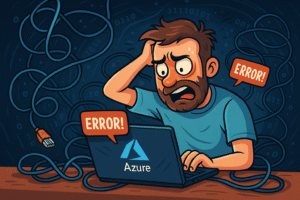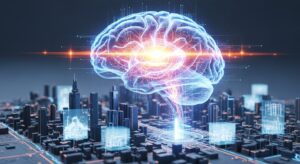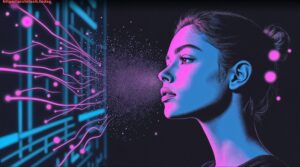Beyond the Algorithm: Why Human Touch is Key in an AI-Powered World
Imagine it’s 2025, and your AI assistant has already outlined your project plan over coffee, cross-referenced stakeholder feedback, and even drafted initial communication strategies. Sounds like a dream, right? Efficiency optimized, time reclaimed, perhaps even a new level of productivity unlocked. Yet, as we race towards this AI-augmented future, a critical question emerges: what about the spark of human creativity that makes a plan truly brilliant, the nuanced empathy needed to navigate complex team dynamics, or the ethical discernment required for decisions that profoundly impact people? In a world increasingly driven by smart machines, the smartest companies are those that unequivocally put people first.
This article isn’t about tempering enthusiasm for artificial intelligence; rather, it’s a thoughtful exploration of how to wield AI as a powerful accelerant without losing the irreplaceable human elements that are critical for sustainable success. For business leaders, product managers, and project leads, understanding this delicate balance isn’t just a philosophical exercise—it’s a strategic imperative. We’ll delve into why human judgment, empathy, and ethical oversight are not mere soft skills but indispensable pillars in an AI-driven landscape, and how embracing a “Human + Machine” synergy leads to superior customer relationships, more engaged employees, and ultimately, a more trusted and resilient brand. Consider this your manifesto for leveraging AI while keeping your organization genuinely human.
The Indispensable Human Element: Why Empathy, Judgment, and Creativity Reign Supreme
In our headlong rush to automate, it’s easy to fall into the trap of believing that if a machine can do it, it should. However, this perspective often overlooks the profound limitations of even the most advanced AI. While AI excels at pattern recognition, data processing, and optimizing predefined parameters, it inherently lacks consciousness, emotional intelligence, and genuine understanding of context. AI can analyze millions of customer interactions in milliseconds, identifying trends and predicting churn with astounding accuracy. But can it truly feel the frustration of a customer, understand the unspoken anxieties of a team member, or conceptualize a truly disruptive product that hasn’t yet manifested in any data set? The answer, unequivocally, is no.
Human judgment, empathy, and creativity are not merely ‘nice-to-haves’ but the very bedrock of innovation and resilient business operations. Take, for instance, a product manager faced with a deluge of user feedback. An AI might categorize and prioritize issues based on frequency and impact, but it’s the human product manager who synthesizes this data with qualitative insights from user interviews, understands the emotional drivers behind a seemingly minor bug, and creatively envisions a solution that delights users in unforeseen ways. Similarly, a project manager might use AI to predict potential delays based on historical data, but it’s their human empathy that allows them to navigate team conflicts, motivate underperforming members, and adapt plans with a nuanced understanding of human limitations and aspirations. Neglecting these human attributes in favor of pure automation is akin to upgrading to a 5G network but insisting on using a dial-up modem for communication—utterly self-defeating. The irreplaceable value lies in our ability to understand context, emotional nuances, and to imagine what does not yet exist.
Empowering Employees, Not Replacing Them: AI as an “Iron Man Suit”
The narrative around AI often defaults to job displacement, fueling anxieties among employees. However, the most forward-thinking organizations are flipping this script, viewing AI not as a replacement force, but as an empowering tool—an “Iron Man suit” for their workforce. This perspective shifts the focus from cost-cutting through headcount reduction to value creation through enhanced human capability. When AI takes on the mundane, repetitive, and data-intensive tasks, it frees up human employees to focus on higher-order activities that demand creativity, critical thinking, strategic planning, and interpersonal engagement.
Consider a marketing team. An AI can automate email campaigns, segment audiences, and even generate basic ad copy. This allows human marketers to dedicate their time to crafting compelling brand narratives, developing innovative campaign strategies, building community, and forging deeper relationships with key influencers. For a product manager, AI can automate feature backlog prioritization by analyzing user behavior and market trends, freeing them to spend more time on strategic roadmapping, engaging with customers to unearth unmet needs, and fostering cross-functional collaboration. Similarly, a project manager can leverage predictive AI tools to identify potential bottlenecks and resource conflicts, transforming their role from reactive problem-solver to proactive orchestrator, focusing on team well-being and strategic alignment. The benefit here is dual: increased efficiency from AI, and heightened job satisfaction and engagement for employees who feel empowered to contribute at their highest potential. When employees feel assisted and uplifted by technology, rather than sidelined, their commitment and innovation soar.
Customer Relations in the AI Era: Building Trust Through Human Connection
Customer experience is the battleground for brand loyalty, and AI offers unprecedented opportunities for personalization and efficiency. AI-powered chatbots can handle a vast volume of routine inquiries, providing instant answers and freeing up human agents. AI can analyze customer data to personalize marketing messages, recommend products, and even predict future needs, creating seemingly seamless interactions. Yet, without a deliberate human touch, these interactions can feel cold, transactional, and ultimately, alienating. The true magic happens when AI enhances, rather than replaces, human connection.
Think of a customer service scenario: an AI bot successfully resolves 90% of routine queries, from tracking orders to password resets. This efficiency is invaluable. However, for the remaining 10%—complex billing disputes, highly emotional complaints, or unique, nuanced problems—the ability to seamlessly escalate to a compassionate, skilled human agent is paramount. Companies that excel in this hybrid model report higher customer satisfaction and loyalty. Customers appreciate the speed of AI but value the empathy and problem-solving skills of a human when it truly matters. Some progressive companies are even explicitly labeling themselves as “AI + Human” teams in their marketing, reassuring customers that while they benefit from cutting-edge technology, a real person is always there for deep, meaningful support. This balance acknowledges that while AI can process information, only a human can truly understand and respond to the emotional undercurrents of customer relationships, turning potential frustration into profound loyalty and trust.
Navigating the Ethical Labyrinth: Human Oversight for Responsible AI
As AI systems become more sophisticated and autonomous, the imperative for robust human oversight grows exponentially. AI models, trained on vast datasets, can inadvertently perpetuate and even amplify existing biases present in the data, leading to discriminatory outcomes in areas like loan applications, hiring decisions, or even criminal justice. The promise of efficiency cannot overshadow the fundamental responsibility to ensure fairness, transparency, and accountability. This is where human ethics committees, review boards, and clear governance frameworks become non-negotiable.
Consider a cautionary tale: an automated lending system, designed for efficiency, inadvertently denied loans to a specific demographic group due to biased historical data it was trained on. Without human oversight and regular auditing, such a system could cause significant PR crises, legal repercussions, and severe damage to a brand’s reputation, not to mention the unfair impact on individuals. The solution isn’t to abandon AI but to embed humans at every critical juncture: from setting the ethical guidelines for AI development, to regularly auditing algorithms for bias, to providing a human in the loop for sensitive decisions. Product managers must champion ethical AI design, ensuring fairness is a core requirement, not an afterthought. Project managers must allocate resources for comprehensive AI governance and auditing. This human-led ethical framework transforms AI from a potential liability into a force for good, ensuring that technological advancements align with societal values and build, rather than erode, public trust.
Cultivating Creativity and Innovation: The Synergy of Human Intuition and AI Data
For too long, the narrative has pitted human creativity against machine efficiency. Yet, the most profound innovations rarely emerge from a singular source. Instead, they arise from the powerful synergy of human intuition, imagination, and the vast analytical capabilities of artificial intelligence. AI is a master at identifying patterns, predicting trends, and processing information at scales impossible for a human mind. But it is the human capacity for divergent thinking, abstract reasoning, and empathetic understanding that transforms data into truly novel, impactful ideas.
Imagine a scenario where human creativity, fueled by AI-driven insights, produces a breakthrough product. A design team uses AI to analyze millions of consumer preferences, social media trends, and even physiological responses to prototypes. This data points to specific unmet needs and aesthetic preferences. However, it is the human designers, with their innate understanding of emotional appeal, cultural nuances, and artistic vision, who synthesize these insights into truly compelling designs that resonate deeply with users. Similarly, a content creation team might use AI to generate outlines, research facts, and even draft initial versions of articles, but it is the human writer who infuses the piece with a unique voice, adds a touch of humor, crafts a clever analogy, and ensures emotional resonance. This partnership allows for rapid iteration and data-informed decision-making, while safeguarding the unique, often unpredictable spark of human genius that defines true innovation. The “Iron Man suit” analogy applies here too: AI handles the heavy data lifting, enabling the human pilot to fly further and faster with unprecedented precision and creative freedom.
The Societal Imperative: Responsibility in the AI Transition
As AI permeates every facet of business and society, organizations bear a significant responsibility beyond mere profit generation. The transition to an AI-driven world is not just about adopting new tools; it’s about reshaping workforces, redefining customer relationships, and influencing societal norms. For business leaders, this means moving beyond a purely operational view of AI and embracing a more holistic, ethical, and human-centric approach to its implementation.
Companies that prioritize their employees’ growth during this transition, using AI to reskill and upskill rather than solely downsize, will foster greater loyalty, innovation, and a positive brand image. Those that design AI systems with clear human oversight, ethical safeguards, and avenues for human intervention will build deeper trust with their customers and the public. This isn’t just good PR; it’s good business. A company known for its humane approach to AI—one that ensures dignity of work, protects privacy, and maintains ethical standards—will attract top talent, earn customer allegiance, and withstand public scrutiny. Ultimately, the successful integration of AI isn’t measured solely by efficiency gains or cost reductions, but by its ability to foster a more humane, equitable, and sustainable future for all stakeholders. This philosophical stance, grounded in practical application, reinforces that technology is a means to an end, and people—whether customers or staff—should remain at the heart of business strategy.
Conclusion: The Future is Human-Powered AI
We stand at the precipice of an extraordinary era, where artificial intelligence holds the promise of unprecedented efficiency, insight, and innovation. Yet, as we’ve explored, the true potential of AI is not realized in its autonomy, but in its synergy with the irreplaceable human element. The smartest companies, the most resilient brands, and the most successful leaders understand that AI is a powerful enhancer, not a solitary solution. It is the amplification of human capabilities—our empathy, our judgment, our creativity, and our ethical compass—that truly unlocks AI’s transformative power.
Embracing AI doesn’t mean discarding humanity; it means elevating it. It’s about leveraging the scale and data processing prowess of machines while cherishing and cultivating the unique qualities that make us human. The most successful strategy isn’t about choosing between AI and humans, but about masterfully combining the efficiency of AI with the creativity and empathy of people. This results in innovation that is not only smart and scalable, but also profoundly humane, ethical, and sustainable for the long term. So, as you chart your organization’s AI journey, ask yourself: how are you ensuring that your AI strategy keeps humanity—in all its complex, brilliant, and emotional glory—firmly at its core?





